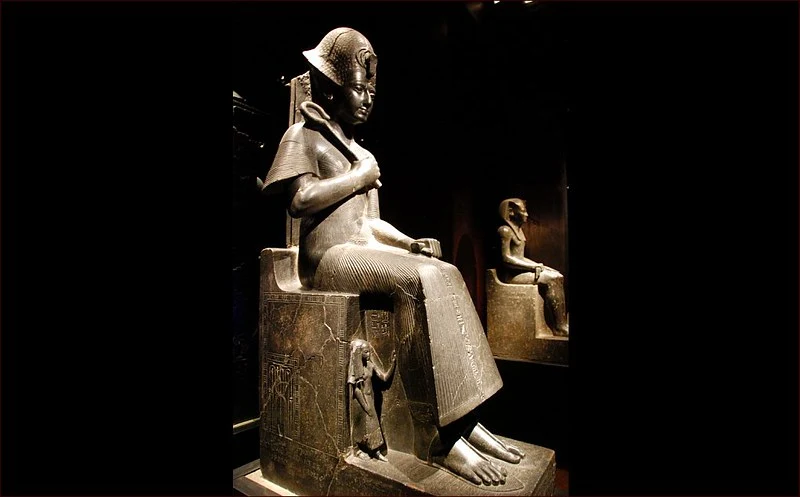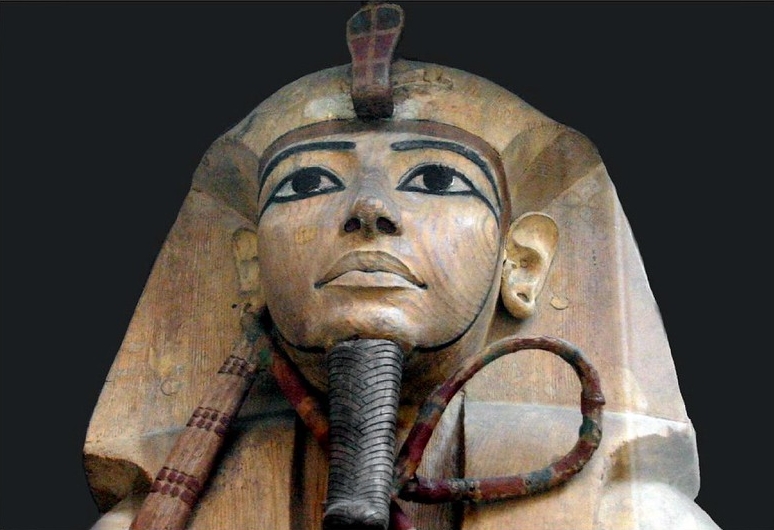The Powerful Protective Power of Ramses II
The Powerful Protective
Power of Ramses II
Ramses II
During the reign of Ramses II he fought for many years to protect the land from the Hittites preserving the ancient culture building many temples and monuments establishing a new capital Ramses II in the Nile Delta renovating almost all the great temples in Egypt Abu Simbel Ramesium Luxor Temple temples in Nubia dedicated to the ancient Egyptian gods and on the art of the festival of Egypt built giant sculptures signed a peace treaty that was discovered at Saqqara, fought as a warrior in the Battle of Kadesh in the fifth year with the Hittites. In the military ability of Ramses II that helped Egypt protect the land.
King Ramses II (Ramesses II). In this most famous portrait of the great ruler ofEgypt the king wears the blue crown and he carries the royal sceptre.
Archaeological records and artifacts from the past pharaohs that have been discovered until today are still clearly visible telling the legend of the era of Ramses II who was at his peak of prosperity. Ramses II the most powerful of all the Pharaohs was born in 1303 BC and died in 1213 BC. He reigned for 66 years and lived a long life. He was declared the second-in-command of the army in line to become the Pharaoh of Egypt. He had about 162 children. The first son of Nefertari Amun-Hur-Kepeshev,and the third son who was the direct successor of Ramses II.
CT Scan Technique of Ramses II's Mummy
After his death he was mummified in the ancient Egyptian way. The internal organs were removed dried with sodium chloride "natural salt" and wrapped in bandages. This ancient Egyptian method preserved the body for the afterlife. Ramses II died at the age of about 90. The mummy of Ramses II reflects the burial techniques of the 19th Dynasty the use of delicate shrouding techniques of ancient pharaohs. The body is still well preserved and preserved with small seeds resin small animal bones in the nasal cavity as with all mummies and linen cloth soaked in resin was also found inside the torso. The standard characteristics of a mummy are remarkable. The body of Ramses II was moved to the Deir el-Bahari cache and ancient Egyptian priests had moved the body of Ramses II from there according to Abrahamic tradition to prevent looting.
In the late 20th century the mummy was sent to the Musée de l Homme in Paris for study and restoration. An official expedition to the site states that he was a dead king. Ramses II was originally buried in KV 7 and his care and examination to this day continue to provide insights to Egyptologists. Although the mummy's incomplete appearance limits the ability to examine the mummy in its poor condition the insights gained from the mummy are limited by the poor condition of Ramses II. Ramses II was buried in the Valley of the Kings according to pharaonic tradition. The mummy of Ramses II has a strong jaw and a hooked nose. It is approximately 1.7 meters (5 ft 7 in) tall. Ramses II died with the symptoms of old age such as arthritis.
Analysis of his bones and teeth along with a large cavity at the base of his left second molar showed evidence of an abscess that could cause pain. Dr. Salim noted clear wear and collapse of the alveoli Historical evidence suggests that he was over 90 years old when he died while the exact cause of death is still unknown. All indications are that Ramses II died of old age. The circumstances of his death are unclear. The mummy of Ramses II was discovered in the Royal Cache TT320 near Deir el-Bahari in the Theban necropolis. It was used by ancient priests to protect the royal and aristocratic mummies from tomb robbers. Local Egyptians excavated the mummy in 1871 and found that it contained the bodies of several pharaohs. This included Ramses II and his father Seti I. Ancient priests wrapped Ramses II's body in linen and placed it in a wooden coffin. His name and title were inscribed on the linen and wooden coffin in the Heratic script.

Lions the powerful guardian
Lions are the kings of the jungle powerful and fierce animals. Lions or Egyptian sphinxes of the giant stone sculptures at the entrances to the temples. The ancient Egyptians believed that two lions guarded the horizon at sunrise and sunset. The Ptolemaic lions crossed legs and different from the typical Egyptian lions or sphinxes lying on their sides may have been considered guardians. The lion of the powerful animals the sitting position symbolizes the lion resting and shows the power of the lion. In the late Ptolemaic period limestone lions were part of the offerings to important temples in cities such as Leontopolis the City of Lions Tel el-Muqdam.
Ptolemaic period, ca. 332-30 BC / Material: Limestone
Egyptian and American archaeologists have discovered the upper torso of a more than 3,200-year-old statue of the Egyptian pharaoh Ramses II dating from the Nineteenth Dynasty of Ancient Egypt. The 12-foot-tall limestone upper torso was recently discovered in the southern Egyptian city of Minya and matches the lower torso of a statue of Ramses II discovered in the 1930s. The limestone upper torso of Ramses II bears inscriptions indicating the date of its construction and the entire statue with its upper and lower torsos stands 7 meters high. The back of the statue is carved with a hieroglyphic inscription praising Ramses II’s name. He wears a double crowned headdress with a cobra symbol. The Egyptian Ministry of Tourism and Antiquities has credited it with powers including protection and healing bringing the dead back to life.
Colossal statue of Ramesses II as a child protected by Horus as a falcon carved in grey granite,
Tanis. Now at the Egyptian Museum.
The protective power of the goddess Isis. A temple painting shows the powerful Ramses II offering lotus flowers to Isis for protection. The power of Isis during Ramses II’s reign and wars. According to legend, Isis was revered as the protector of his son Horus. The relationship between Isis and Horus The power of Isis as a powerful and benevolent goddess emphasizes Ramses II’s power to protect her during his reign and wars, as did other pharaohs, and is associated with the “Eye of Horus,” a falcon-headed god who was an important symbol of protection for Isis. Ramses II was considered powerful during the years of war with the Hittites and his long reign in ancient Egypt..
His wife Queen Nefertari is shown at his feet. Diorite (1279-1213 BC). Egyptian Museum, Turin.
Battle with me at Kadesh ability and powerful army of 100,000 men won the victory over the enemy during the reign of Ramses II fought in Syria and Palestine and invaded the south. In the history of Egypt The construction and restoration of important temples in the main city there are two large temples at Abu Simbel the monuments built, built the largest building in Egypt among the monuments and signed the first recorded treaties. He reigned for 67 years. The legend of Ramses II's power and rituals to the gods and nature are forever immortalized in the sacred stone statues carved into the rock making it stand out reflecting the relationship of Ramses II with the god of Ra.
In this coffin the great pharaoh Ramesses II was discovered by archaeologists.
Rituals to the gods of the pharaohs who were highly revered by the gods. Excavation of ancient artifacts important points in these territories will help Egyptologists get a more accurate and precise picture of some of the hypothetical structures. King Ramses II of the 19th Dynasty of Egypt who lived about 3,300 years ago and was known as Ramesses the Great was widely regarded as one of the most influential pharaohs in the New Kingdom of ancient Egypt which was the most powerful. Archaeologists believe that these mummies were intended to honor the pharaoh. Dr. Sameh Iskandar the head of the excavation team said that there will be an official press conference to provide more details.
The Egyptian Ministry of Tourism and Antiquities and the team said that it was an “unprecedented” phenomenon. The discovery was made at a site about 435 kilometers south of Cairo. The team excavated and found remains that were between 4,300 and 1,000 years old including other statues leather shoes remains of trees clothes and papyrus. For Ramses II over 2,000 animal mummies were found at the ancient Egyptian temple of Ramses II including the heads of rams (most numerous), dogs, goats, cattle, deer, mongooses and ostriches. The offerings were another indication of how much he was admired in ancient Egypt and the fulfillment of vows to this god shows the great devotion the ancient Egyptians had towards their gods.
meisterdrucke.ie
egypt-museum
madainproject















